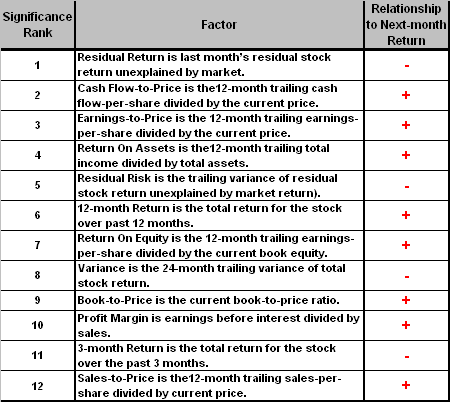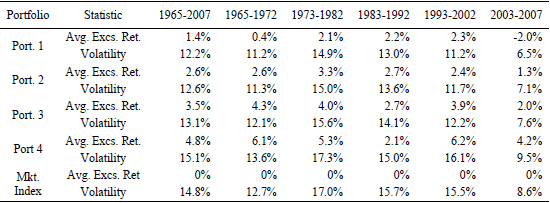What fundamental and technical factors are optimum for stock selection, and how well do they work? In the October 2008 draft of their paper entitled “Case Closed”, flagged by a reader, Robert Haugen and Nardin Baker present a model of future stock returns based on multiple regressions of 12 factors they find most significant in predicting monthly returns. Using monthly data for a sample of U.S. stocks over the 45-year period 1963-2007, they conclude that:
- There are negative payoffs to measures of risk, positive payoffs to measures of current profitability, positive payoffs to measures of cheapness, positive payoffs to stock return momentum and negative payoffs to recent stock performance (see the first table below).
- The 10% of stocks with highest expected return outperform the 10% with the lowest expected return in all sample years but one.
- The 10% of stocks with highest expected returns tend to have: low risk; highly profitability; positive trend in profitability; low price relative to current earnings, cash flow, sales and dividends; relatively large market capitalization; and, positive price momentum over the previous year. The 10% with the lowest expected returns have exactly the opposite profile, and there is a smooth transition across deciles.
- Results hold consistently across five subperiods.
The following table, constructed from information the paper, ranks the 12 most statistically significant factors for predicting future monthly returns for individual stocks over the entire sample period. It shows whether the relationship between each factor and next-month returns is positive or negative.

The next table, taken from the paper, summarizes average annualized excess returns and volatilities of four portfolios formed based on these factors, and designed to accept increasing levels of risk, over the entire sample period and various subperiods. All portfolios are long only, limited to the largest 1,000 stocks, rebalanced quarterly, constrained to promote diversification and constrained to limit turnover. The benchmark for excess returns is the Russell 1000 stock index when available and the S&P 500 stock index before then. Results do not include trading costs (but the authors assert that “transactions costs would have to be unrealistically extreme to significantly close the gap between the high expected return portfolios and the market index.”)

Hedge portfolios that are long (short) the stocks with the highest (lowest) expectations may generate stronger gross returns.
In summary, investors may be able to outperform the broad market by screening stocks on the 12 most reliable fundamental and technical factors.
Note the additional information on this model available at the Haugen Custom Financial Systems web site.